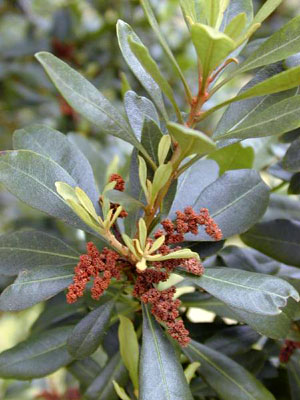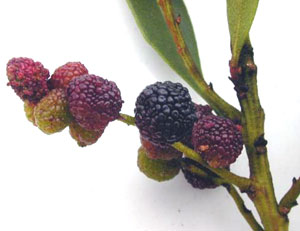Contents:
Common Names | Parts Usually Used | Plant(s) & Culture | Where Found | Medicinal Properties | Biochemical Information
Legends, Myths and Stories | Uses | Formulas or Dosages | How Sold | Warning | Bibliography
Scientific Names

- Myrica cerifera L.
- Myricaceae
- Myrtle family
Common Names
- American bayberry
- American vegetable tallow tree
- American vegetable wax
- Bayberry bush
- Bayberry wax tree
- Candleberry
- Candleberry myrtle
- Katphala (Sanskrit name)
- Myrtle
- Tallow shrub
- Vegetable tallow
- Wax berry
- Wax Myrtle
- Yang-mei
Parts Usually Used
Bark, leaves, flowers
Back to Top
Description of Plant(s) and Culture

Coarse, stiff, shrub or small, slender, tree; to
Back to Top
Where Found
Sandy swamps, thickets, marshes and wet woodlands. Southern New Jersey to Florida, Texas to Arkansas. West Indies
Back to Top
Medicinal Properties
Stimulant, astringent, emetic, antispasmodic, alterative, expectorant, diaphoretic, tonic. Leaves – aromatic, stimulant
Back to Top
Biochemical Information
Volatile oil, starch, lignin, albumen, gum, tannic and gallic acids, acrid and astringent resins, an acid resembling saponin
Back to Top
Legends, Myths and Stories
One of the most versatile herbs, this native American plant is highly regarded by herbal practitioners. Nineteenth century physicians used to prescribe a hot tea made from the powdered bark of the bayberry at the first sign of a cold, cough, or flu.
Wax of the berries is used to make fragrant candles. To obtain the wax, boil the berries in water. The wax floats to the surface and can be removed when hardened.
Gather root bark in the fall. Cleanse it thoroughly and while fresh separate the bark with a hammer. Dry the root completely and keep in a dry place; when dry enough to pulverize do so and store in a dark glass or pottery sealed container.
Back to Top
Uses
Bayberry is considered one of the most useful in the Medical Herbal practice. Its popularity has had respect for generations.
Candle wax is produced from the fruits.
Root bark formerly used in tea as an astringent and emetic for chronic gastritis, diarrhea, dysentery, leukorrhea, mouthwash for sore, bleeding, or sensitive gums, is good for circulation, catarral states of the alimentary tracts, jaundice, scrofula, bowel inflammation, excessive menstrual bleeding and uterine discharge, and indolent (hard to heal) ulcers. Leaf tea was used for fevers, sore throats, bronchitis, cholera, typhoid, epilepsy, indigestion, hemorrhoids, externally as a wash for itching. Powdered root bark was an ingredient in “composition powder”, once a widely used home remedy for colds, flu, laryngitis, sinusitis, asthma, and chills.
Bayberry bark powder makes an excellent toothpowder, combined with cinnamon bark powder, myrrh, salt, and echinacea root. Good results used for goitre.
A decoction is used as a wash or poultice for varicose veins, chronic sores, boils, or the powdered bark may be directly applied to wounds. The oil of Bayberry is good for bruises.
Bayberry is excellent as an emetic after narcotic poisoning of any kind. It is good to follow the bayberry with lobelia.
Back to Top
Formulas or Dosages
Tea: steep
Extract: mix
Mouthwash: gargle with liquid mixture made of extract or powder as needed.
Powder: mix
Tincture:
Externally: rub liquid mixture on varicose veins or hemorrhoids as needed.
Back to Top
How Sold
Capsules: take
Back to Top
Warning
Wax is irritating. Constituents of the wax are reportedly carcinogenic.
Avoid in very hot temperatures. Avoid if hypertensive.
Back to Top
Bibliography
![]() Back to Eden
Back to Eden, by Jethro Kloss; Back to Eden Publishing Co., Loma Linda, CA 92354, Original copyright 1939, revised edition 1994
![]() Eastern/Central Medicinal Plants
Eastern/Central Medicinal Plants, by Steven Foster and James A. Duke., Houghton Mifflin Company, 215 Park Avenue South, New York, NY 10000
Herbal Gardening, compiled by The Robison York State Herb Garden, Cornell Plantations, Matthaei Botanical Gardens of the University of Michigan, University of California Botanical Garden, Berkeley., Pantheon Books, Knopf Publishing Group, New York, 1994, first edition
![]() The Herbalist Almanac
The Herbalist Almanac, by Clarence Meyer, Meyerbooks, publisher, PO Box 427, Glenwood, Illinois 60425, copyright 1988, fifth printing, 1994
 Earl Mindell’s Herb Bible
Earl Mindell’s Herb Bible, by Earl Mindell, R.Ph., Ph.D., Simon & Schuster/Fireside, Rockefeller Center 1230 Avenue of the Americas, New York, New York 10020
![]() Planetary Herbology
Planetary Herbology, by Michael Tierra, C.A., N.D., O.M.D., Lotus Press, PO Box 325, Twin Lakes. WI 53181., Copyright 1988, published 1992
![]() American Folk Medicine
American Folk Medicine, by Clarence Meyer, Meyerbooks, publisher, PO Box 427, Glenwood, Illinois 60425, 1973
 Secrets of the Chinese Herbalists
Secrets of the Chinese Herbalists, by Richard Lucas, Parker Publishing Company, Inc., West Nyack, NY, 1987.
![]() The Complete Medicinal Herbal
The Complete Medicinal Herbal, by Penelope Ody, Dorling Kindersley, Inc, 232 Madison Avenue, New York, NY 10016, First American Edition, copyright 1993
![]() Indian Herbalogy of North America
Indian Herbalogy of North America, by Alma R. Hutchens, Shambala Publications, Inc., Horticultural Hall, 300 Massachusetts Avenue, Boston, Massachusetts 02115, 1973
![]() The Yoga of Herbs: An Ayurvedic Guide to Herbal Medicine
The Yoga of Herbs: An Ayurvedic Guide to Herbal Medicine, by Dr. David Frawley & Dr. Vasant Lad, Lotus Press, Twin Lakes, Wisconsin, Second edition, 1988.
![]() Webster’s New World Dictionary
Webster’s New World Dictionary, Third College Edition, Victoria Neufeldt, Editor in Chief, New World Dictionaries: A Division of Simon & Schuster, Inc., 15 Columbus Circle, New York, NY 10023
 The Rodale Herb Book: How to Use, Grow, and Buy Nature’s Miracle Plants (An Organic gardening and farming book)
The Rodale Herb Book: How to Use, Grow, and Buy Nature’s Miracle Plants (An Organic gardening and farming book), edited by William H. Hylton, Rodale Press, Inc. Emmaus, PA, 18049., 1974
